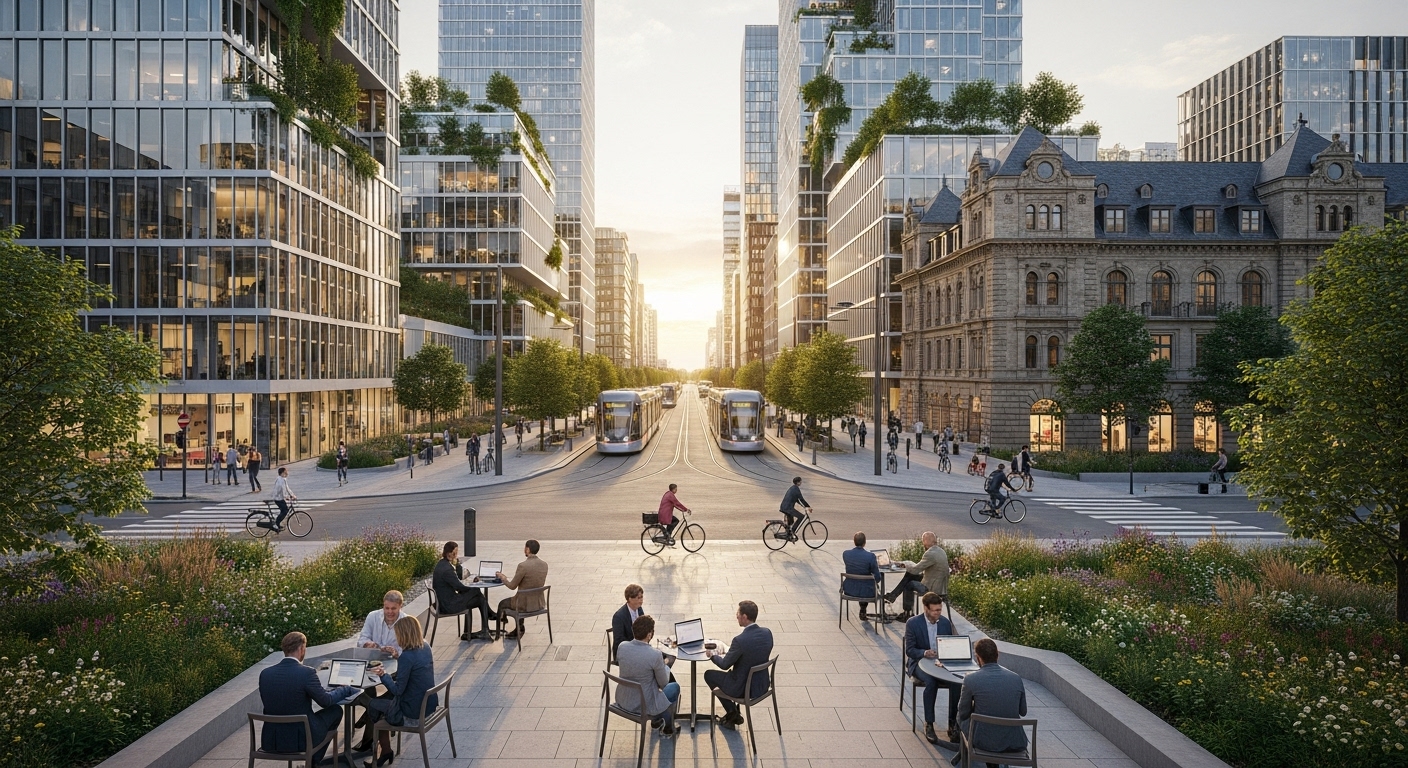Europe’s business districts, long the bastions of corporate power and economic might, are undergoing a seismic transformation. The traditional skylines of cities like London and Paris are no longer the sole indicators of commercial influence. A new, dynamic landscape is emerging, sculpted by the powerful forces of technological innovation and an urgent, continent-wide push for sustainability. As companies rethink the very nature of work in a post-pandemic world, the most successful business hubs are evolving from sterile, nine-to-five monoliths into vibrant, integrated ecosystems. This evolution is critical for attracting top talent, fostering innovation, and securing a competitive edge in the global market. This article explores this profound shift, examining how established giants are adapting and how a new league of challenger cities is rising to prominence by embedding technology and green principles into their urban fabric.
The titans of trade: How legacy hubs are reinventing themselves
The traditional powerhouses of European commerce are not resting on their laurels. Cities like London, Paris, and Frankfurt are actively future-proofing their business districts to meet the demands of a new era. In London, Canary Wharf is a prime example of this adaptation. Once a pure financial monolith, it has successfully diversified to become a major hub for technology and media companies, demonstrating a strategic pivot to attract a broader range of industries. Similarly, Paris’s La Défense, the largest purpose-built business district in Europe, has leveraged Brexit to attract financial institutions seeking a solid foothold within the EU. Beyond finance, Paris is cementing its status as a major tech hub, with global events like Viva Technology highlighting its burgeoning innovation scene. Frankfurt, long known as “Mainhattan” for its banking prowess and home to the European Central Bank, is focusing on enhancing its digital infrastructure and green credentials to complement its financial strength. Amsterdam’s Zuidas district continues to thrive due to its exceptional connectivity and strategic location, making it a magnet for international legal, financial, and tech corporations. These legacy hubs understand that relevance is not a given; it must be continually earned through strategic reinvention, diversification, and a commitment to creating more flexible and appealing urban environments for a modern workforce.
The challenger cities: A new wave of innovation hubs emerges
While the established giants evolve, a fresh crop of challenger cities is reshaping Europe’s economic map, often building their success on specialized tech niches and superior quality of life. Lisbon has rapidly emerged as a vibrant tech and startup hub, attracting a global pool of entrepreneurs and digital nomads with its appealing lifestyle and supportive government incentives. In Northern Europe, Helsinki is carving out a reputation as a powerhouse in the deep-tech and gaming industries, bolstered by strong public sector support for early-stage companies. Barcelona’s 22@ innovation district stands as a globally recognized model of successful urban regeneration. It has masterfully transformed a derelict industrial area into a thriving nucleus for technology, research, and knowledge-based companies, proving that strategic urban planning can cultivate innovation from the ground up. Meanwhile, Berlin continues to leverage its creative and entrepreneurial spirit, nurturing a dynamic startup ecosystem with particular strengths in fintech and the creative industries. These rising stars are not trying to replicate the models of London or Paris. Instead, they are forging their own paths, proving that a potent combination of specialized industry focus, government support, and a high quality of life can create formidable business districts that attract significant talent and investment, signaling a more decentralized and diverse future for European commerce.
The green imperative: Sustainability as a core development principle
Across Europe, sustainability has transitioned from a corporate buzzword to a fundamental principle guiding the very architecture and operation of modern business districts. This green imperative is driven by regulatory pressure, investor demand, and a growing recognition that sustainable environments are crucial for attracting and retaining top talent. The ‘New European Bauhaus’ initiative exemplifies this commitment at a policy level, promoting the development of living and working spaces that are not only sustainable but also inclusive and aesthetically pleasing. This philosophy is being translated into concrete reality across the continent. In Luxembourg, the Kirchberg district is being reimagined as a sustainable neighborhood, focusing on cradle-to-cradle building concepts and championing green mobility with free public transportation. Sweden’s Västra Hamnen in Malmö is a world-leading example of a regenerated district, striving to be a carbon-neutral community powered by renewable energy. Even established cities are making significant strides; Paris is actively promoting green buildings with vertical gardens and eco-friendly materials, while cities like Copenhagen and Hamburg are celebrated leaders in green urban planning, boasting extensive cycling infrastructure and ambitious carbon-neutrality goals. This focus on sustainability is creating healthier, more attractive urban spaces and delivering a tangible return on investment through lower operational costs and enhanced brand reputation.
Smart districts: The integration of technology into the urban fabric
Technology is the other key catalyst revolutionizing European business districts, transforming them into interconnected, responsive, and efficient ‘smart districts’. The integration of technology is happening at every level, from individual buildings to city-wide infrastructure. The rise of Property Technology, or Proptech, is at the forefront of this change. Startups across the UK and Germany are leading the charge, developing innovative solutions for digital property management, enhanced energy efficiency, and streamlined real estate transactions. Beyond individual properties, cities are leveraging technology to create smarter urban environments. London and Barcelona are implementing comprehensive smart city strategies, while Amsterdam utilizes smart parking solutions to manage traffic flow and reduce congestion. The European Commission actively supports this transition through its ‘Smart Cities Marketplace,’ which fosters the collaboration needed to develop digital solutions for more sustainable and efficient cities. This technological layer is not just about efficiency; it’s about creating a better human experience. By using data to understand how people interact with the urban environment, planners can optimize public transport, improve safety, and create more engaging public spaces, making the business district a more attractive place to work, live, and collaborate.
The future of work: How hybrid models are reshaping physical space
The widespread adoption of hybrid and remote work is perhaps the most significant force reshaping the physical layout and purpose of European business districts. The office is no longer simply a place to house employees; it is evolving into a destination for collaboration, innovation, and fostering corporate culture. This shift demands a fundamental rethink of office design and the amenities offered within a business district. In response, districts like La Défense are adapting by encouraging the development of more flexible and collaborative workspaces. The traditional sea of cubicles is giving way to dynamic environments with a mix of private focus areas, open-plan collaborative zones, and high-tech meeting rooms designed to seamlessly connect in-person and remote participants. This trend has also fueled the explosive growth of co-working spaces and serviced offices, which offer businesses the agility to scale their physical footprint up or down as needed. To draw employees back to the office, companies and developers are creating amenity-rich environments that blend work with lifestyle, incorporating high-end fitness centers, diverse food and beverage options, green spaces, and cultural venues. The business district of the future is not just a place of work but a vibrant hub that supports a holistic and integrated lifestyle.
Navigating the new landscape: Key factors for business location
In this evolving European landscape, the criteria for selecting a business location have become more complex and multifaceted than ever before. While traditional factors like transportation links and proximity to clients remain important, they are now weighed alongside a new set of priorities shaped by the trends in technology, sustainability, and talent expectations. Access to a deep and diverse talent pool is paramount, and businesses are increasingly drawn to cities with a high quality of life, excellent educational institutions, and a vibrant cultural scene. A city’s commitment to sustainability is now a critical factor, as companies look to align their physical presence with their corporate social responsibility goals. This includes the availability of green-certified buildings, access to sustainable transport options, and the city’s overall environmental policies. Furthermore, the technological infrastructure of a district is a key consideration. Businesses require robust digital connectivity, a supportive proptech ecosystem, and smart city features that enhance efficiency and the employee experience. The flexibility of the real estate market is also crucial, with a growing demand for a mix of traditional leases, serviced offices, and co-working spaces that can accommodate agile and hybrid work models. Ultimately, the optimal business district is one that functions as a strategic partner, offering an ecosystem that supports innovation, attracts top talent, and aligns with the values of a forward-thinking global enterprise.
In conclusion, the narrative of Europe’s business districts is being actively rewritten. The era of the monolithic, single-purpose commercial zone is fading, replaced by a more dynamic, human-centric, and resilient model. The most forward-thinking districts are those that successfully weave together the threads of technological innovation and deep-rooted sustainability. They are transforming into smart, green ecosystems that prioritize not only economic output but also the well-being of their inhabitants and the health of the planet. This evolution is creating a more decentralized and competitive landscape, where both established titans like London’s Canary Wharf and emerging hubs like Barcelona’s 22@ district must continually innovate to attract talent and investment. For businesses navigating this new terrain, the choice of location is no longer just a logistical decision; it’s a strategic one that reflects their brand, their values, and their vision for the future of work. The skylines of Europe will continue to change, but the most significant transformation is happening at street level, in the creation of business districts that are smarter, greener, and more connected than ever before.





